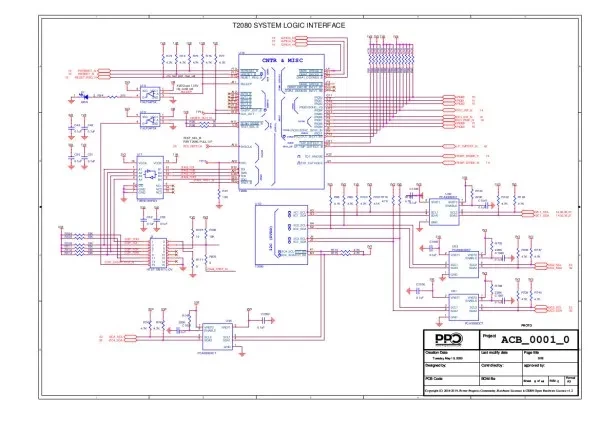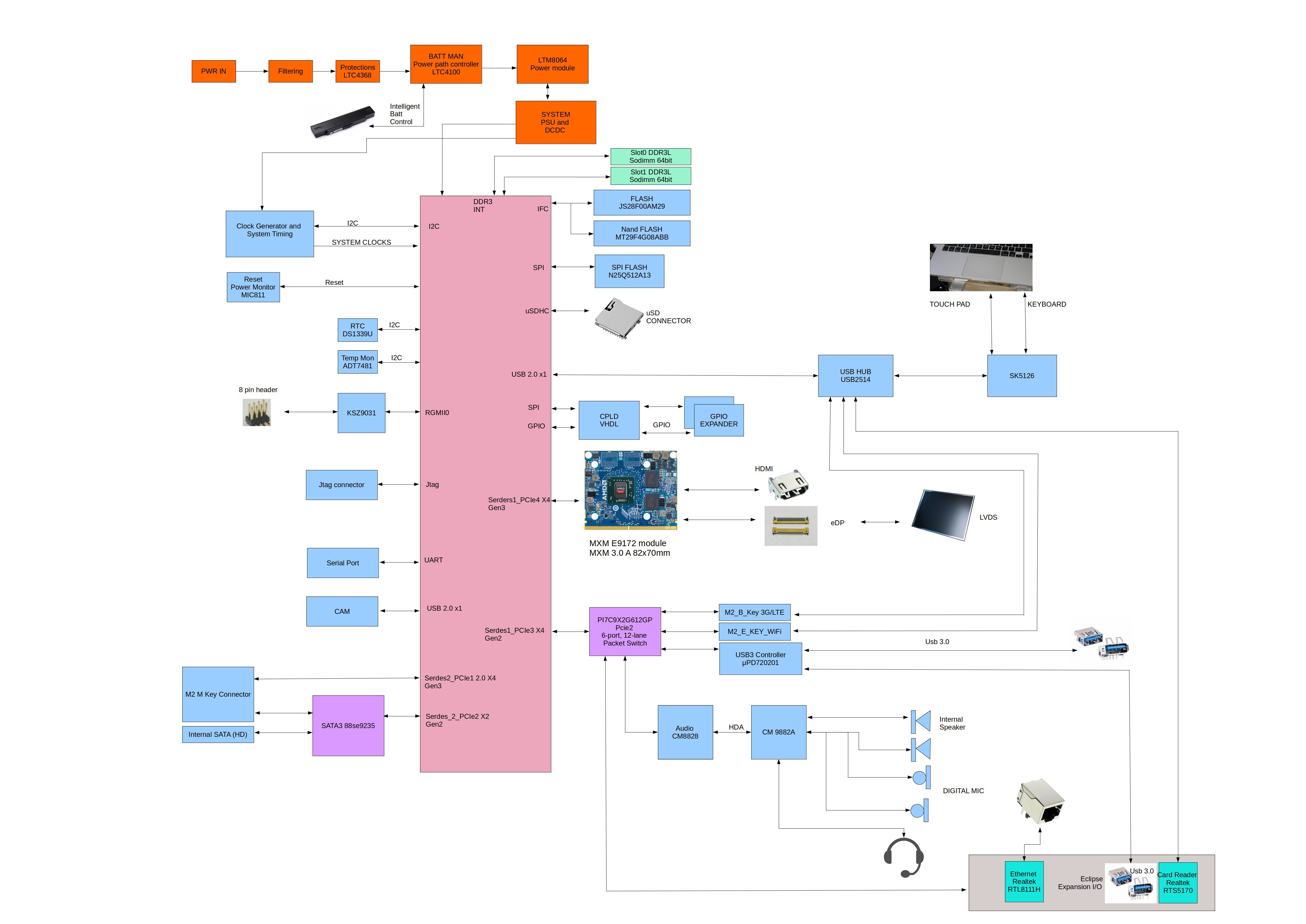In the last log we mentioned that a new version of the electrical schematics is in the works. After a few rounds of internal reviews and changes, that new version is now finally ready to be publicly shared.

We publish a PDF version of the schematics exported from the ORCAD software that is being used by the designer. You may navigate through the document and investigate each component, but unluckily, due to the complexity of the document some PDF viewer may be unable to correctly visualize its content, if that happens just change the viewer you are using.
After receiving these new schematics, we already requested a new round of changes to the designer, in particular we would like to raise the motherboard power consumption footprint up to 90W in order to support higher ends MXM 3 video cards that consume a maximum of 55W. As an example, the AMD Radeon E9174 (GCN 4.0) has a TDP of 50W. The idea is to obtain a new version of electrical schematics before the end of May.
If you think a TPD of 90W is too much for a laptop, I can tell you that while I am typing this post on my laptop (a DELL XPS 15 9570, released in 2018) I have attached a power meter to the power brick and the power consumption bounces between 40W and 90W (dunno why is going up and down, I have only a browser turned on). I have also tried playing some 3D games on my DELL laptop, and the power consumption reaches picks of 110W, and sometimes even higher, up to the limit of the power brick, which is 130W.
The current version of the motherboard, as you can see in the electrical schematics at pages 3 and 4 of the PDF, there are two SO-DIMM DDR3L slots that can host DDR3L non-ECC (max 1866 MT/s, PC3-14900). We opted for non-ECC modules as they are way easier to find on the market and are less expensive than ECC ones, so it will be easy to have 32GB of RAM (2x16GB), up to a limit of 64GB of RAM, if you can find 32GB SO-DIMM modules.

Thanks to the project’s supporters (here a list of donors) and in spite of the current difficult times due to the coronavirus impact on everyone’s life, we reached 60% of the goal of the current step, making us confident that it will be possible to obtain the PCB design in a reasonable time frame.
Still, we still have to raise the remaining 40% (€7600 / $8400) to reach the current goal and we kindly ask any of you to continue supporting the donation campaign.
We also invite anyone that is capable of helping us in the technical review of the hardware schematics to contact us, as that would help us to speed up the design process as well as improve the overall quality of the final motherboard.
We finally would like to stress that the PowerProgressCommunity association behind this project has the long-term goal to lower the existing barriers for accessing and sharing technological knowledge. Being able to freely share a laptop motherboard schematics will dramatically improve the current situation where access to these kinds of data is difficult for who is working in the field, let’s imagine how difficult it is for who is just approaching the topic like students and hobbyists. In addition, by stressing on alternative, non-mainstream technologies, will help spread a culture of diversity, so much important in a flattening world where younger generations don’t even imagine that a different architecture from x86 or ARM exists.
Working on U-Boot

Our NXP T2080RDB devkit boots with AMD RadeonHD video cards using GNU/Linux PPC distros. So far we have successfully tested Debian 10, OpenSuse, VoidLinux, and Fienix. However, due to a lack of involved people expert on U-Boot, we are still lacking support for video output during the boot process, just before the linux kernel kicks in. Very recently, a couple of supporters experts in this field contacted us and joined the group. Thanks to their help, we are confident to solve the current situation, and even update U-Boot from the latest sources. Hopefully, we will be able to publish a new post with some good news in the not-so-distant future.
Interview to Roberto Innocenti about our project thanks to Charbax of ARMDevices
At the end of April, thanks to Charbax of Armdevices.net, there was an interview with Roberto Innocenti, the first creator of the idea of building a PowerPC laptop and co-founder of the PowerProgressCommunity. The interview was about the laptop project and other activities carried out by the not-for-profit association. Below you may find the topics touched in the interview. We think that the interview is interesting and contains many hints on the approach we are following, even if the spoken English of Roberto is sometimes difficult to follow. During the interview one person asked about the Manjaro distro for PowerPC, and after some check, it seems that such a distro lacks a PowerPC support.
0.13 Self-introduction of Roberto Innocenti
0.45 Power Progress Community non-profit association
1.34 PowerPC notebook project
3.15 PowerPC architecture history
6.13 OpenPOWER Foundation
7.11 Why NXP CPU and not IBM
9.40 PowerPC on Linux
11.35 Linux distributions runnable on PowerPC
13:36 Future of embedded PowerPC
15:21 Cell processor interesting facts
18:27 Schematics and diagrams of PowerPC notebook project
19:31 NXP CPU specification
20:13 Upgradable AMD Radeon MXM GPU
21:02 Contribution of Power Progress Community and ACube Systems Srl
22:24 TDP, commercial usage and capabilities of NXP CPU
27:40 Supported kinds of storage
28:28 More about AMD Radeon MXM GPU
30:14 Old PowerPC MacBook performance compared to PowerPC notebook dev kit
31:41 Is Roberto Innocenti is better than Steve Jobs? 😉
32:25 People behind the PowerPC notebook project
34:07 PowerPC compared to ARM
37:35 More about OpenPOWER Foundation
40:43 Donation campaign details
43:52 Slimbook Eclipse chassis
46:50 What about small-desktop/NUC style device?
48:44 Estimated price of PowerPC notebook
51:55 Manufacturing of components
52:50 COVID-19 situation
56:23 Young people involved in PowerPC notebook project
57:11 Diversity of hardware designing, production and distribution
1:04:50 Transparency of NXP CPU
1:06:13 More about manufacturing of components and dependence on China
1:09:21 Ubuntu and Debian on PowerPC
1:11:03 Manjaro and other Linux distributions on PowerPC
1:12:30 Current phase of donation campaign
1:14:00 Potential successor of NXP CPU
Complete post....
 Roberto Innocenti
Roberto Innocenti
Discussions
Become a Hackaday.io Member
Create an account to leave a comment. Already have an account? Log In.